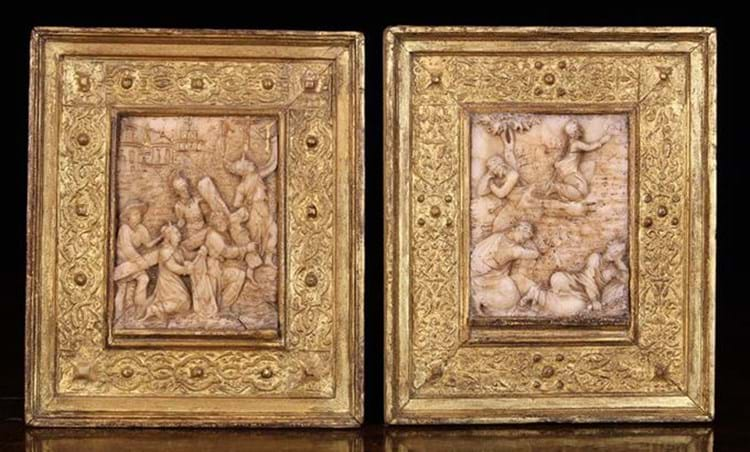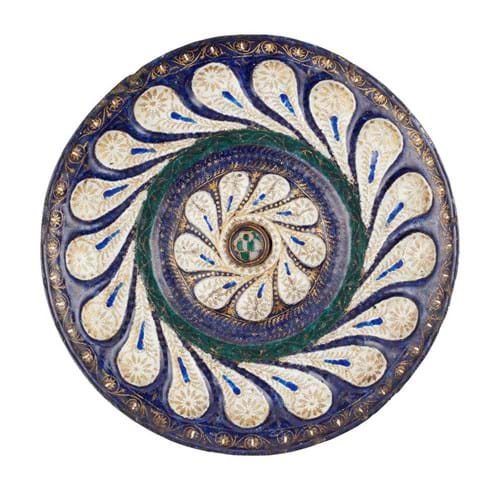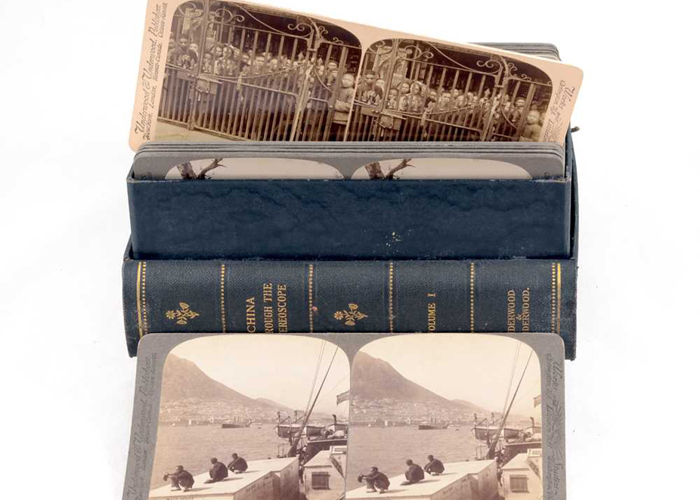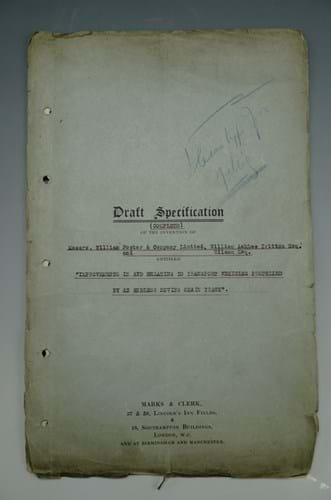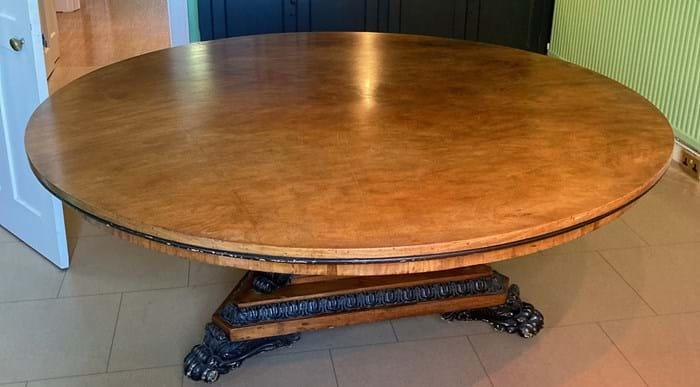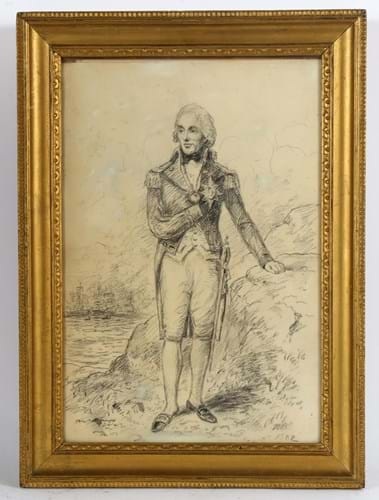1. Mechelen alabaster sculptures – £15,200
The town of Mechelen in Antwerp was a major centre of alabaster sculpture from the mid-16th century onwards. The craftsmen there even had a dedicated name: they are described in trade guilds as cleynstekers (meaning sculptors of small scale works) and albastsnijders (alabaster cutters).
The narrative panel, typically depicting scenes from The Passion, was the mainstay of the Mechelen cleynstekers. There was something of a production line for these, particularly after the Southern Provinces were reconquered by Catholic Spain in 1585.
Examples come to sale quite frequently in continental Europe but less often in the UK. The pair pictured here c.1700 are carved with The Way to Calvary (Saint Veronica offering her veil to Christ) and The Garden of Gethsemane. Both enriched with gilt detailing, they are set in its original gilt and strap-work frames measuring 9 x 8in (23 x 20cm).
They formed part of the contents of Twyssenden Manor, a Tudor manor house in 258 acres of land near Goudhurst in Kent, offered for sale by specialist oak auctioneers Wilkinson’s in Doncaster on February 27. The property had spent much of the 20th century as a youth hostel but was purchased by the late owner in the late 1990s and fully restored and furnished in period style.
Estimated at £2000-3000, they went to a UK private collector at £15,200.
2. Venetian enamel charger – £75,000
The Five Centuries sale at Lyon & Turnbull on February 23-24 featured items from Borders property Kimmerghame, Duns, home of the Swinton family. The estate of Major General Sir John Swinton included some notable British and Continental works of art led by this 15th century Venetian enamel charger.
Although Venice, a melting pot of Eastern and Western influences during the Renaissance, was a major centre for the production of enamels on copper, only a few hundred pieces are known in private collections and museums.
Many of the surviving examples were clearly for use in a religious context. However, this 11in (28cm) dish with its central silver and green armorial indicates it was commissioned by an aristocratic family.
Estimated at £30,000-50,000, it took £75,000.
3. China Through the Stereoscope photographs – £3200
The Photographica sale at Chiswick Auctions on February 28 included this rare set of China Through the Stereoscope. Published by Underwood & Underwood of New York & London in 1901, this is the complete set comprising 100 numbered and captioned photograph stereoviews, the accompanying book and a booklet of eight folding maps showing location of each image.
It comes in a card and cloth box formed as a three volume book.
The photographs, taken by American travel photographer James Ricalton as he toured the country, are important as they document a volatile period in the final years of Imperial China. Ricalton arrived in Tianjin in July 1900 when the city was under siege from the Boxers and went to Peking shortly after the Siege of the Legations had been lifted.
The contents were recently reprinted as a book under the title A Journey Through the Dragon Empire at the Time of the Boxer Uprising.
This 1901 set was in very good, lightly used condition. Estimated at £200-300, it sold at £3200.
Another set sold at £2900 at Dominic Winter in December 2020.
4. First World War tank blueprint – £14,600
On February 25-26, Laidlaw of Carlisle offered what is thought to be the only known blueprint of a First World War British Mark I tank, the world’s first tracked armoured fighting vehicle.
The highly detailed large scale technical plan was used in its design and construction. It bears the ink stamps of the designers and manufacturers of the tank, William Foster & Co Limited, Engineers, Lincoln, and is dated May 18, 1916, just a few months prior to the first use of the tank on the morning of September 15 during the Battle of Flers-Courcelette, part of the Somme Offensive.
It is accompanied by a patent specification for the tank titled Improvements in and relating to transport vehicles propelled by an endless moving chain track. Also dated 1916, it runs to some 20 pages of typewritten text with pencil annotations and corrections.
The blueprint and patent specification carried an estimate of £15,000-25,000 and found a buyer just below this at £14,600.
5. 19th century breakfast table – £32,000
This early 19th century walnut and ebonised circular breakfast table, offered for sale at Hawleys at the Beverley Racecourse on February 26, is very much in the Grecian revival style. A table of this form with a pyramidal base and muscular paw feet, is illustrated in Household Furniture and Interior Decoration... executed from designs by Thomas Hope, London, 1807 – a publication used by many Regency cabinet-makers as a pattern book.
This 5ft 4in (1.93m) diameter example (probably London made) came by family descent from large house on Richmond Hill, Leeds and had been pictured in situ by Yorkshire Life magazine in 1952 at Hall Garth, Goodmanham. A copy of the magazine was included in the lot.
Described as “in good condition with all original fittings” it was estimated at £2000-3000 but sold at £32,000.
6. Charcoal drawing of Lord Nelson – £2500
Estimated at £100-150, this charcoal drawing of Lord Nelson by William Beechey (1753-1839) sold for £2500 at Burstow & Hewitt in Battle, East Sussex on February 25. Signed with a monogram with an additional artist's inscriptions verso, the 39cm x 26cm sketch is also dated 1802.
Beechey painted Nelson on several occasions, the oil study in the National Portrait Gallery from 1800 considered the most faithful likeness of the admiral. It was used as a preparatory study for a full-length portrait commissioned by the City of Norwich which now hangs in Andrews Hall in Norwich. It was later engraved as a mezzotint by Richard Earlom (1743-1822) and published in 1805 shortly after Trafalgar.
The charcoal sketch, done three years earlier, shows Nelson adopting a different pose looking to the right, rather than the left.


